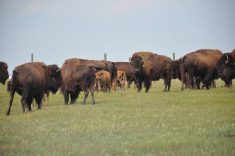PHOENIX, Ariz. – The risk of disease transmission between wildlife and livestock is a controversial topic for cattle producers.
“When wildlife are implicated as a livestock disease reservoir, we get friction between livestock and wildlife interests,” said Victor Nettles, a wildlife veterinarian from the University of Georgia.
The debate was held during a special forum at the National Cattlemen’s Beef Association convention in Phoenix last week.
A good example is the controversy at Wyoming’s Yellowstone National Park, which has been smoldering since bovine brucellosis was found in the park’s bison nearly a century ago.
Read Also

Trump’s tariffs take their toll on U.S. producers
U.S. farmers say Trump’s tariffs have been devastating for growers in that country.
Many cattle producers favor killing the entire bison herd to prevent transmission to cattle and domestic elk.
Wildlife groups argue the disease is a natural condition to which the 3,000 park bison are adapted.
About 50 percent of the Yellowstone bison are infected. Infection rates in elk are as high as 22 percent.
A 1995 federal government study found the organism that causes bovine brucellosis in bison is virtually the same as that diagnosed in cattle, said Jack Rhyan, with the United States Department of Agriculture’s national wildlife research centre in Colorado.
The disease is not dormant and people like Idaho state veterinarian Bob Hillman believe it causes abortions in bison.
Rhyan and other officials want the Yellowstone bison vaccinated, but the park service worries a vaccine might infect other species in the park.
A secondary concern is the effect the infected bison have on American trade, said Hillman.
The U.S. can never have brucellosis-free status as long as brucellosis is found in bison and elk, even though many states have cleared their cattle herds of the disease.
“Cattlemen have done what they could to get rid of brucellosis, but they are held back by policies affecting Yellowstone,” Hillman said.
“Because of the reservoir of disease that is present in that area, people have a distrust of livestock from that area.”
In Michigan there is broad support among five government departments to clean up tuberculosis discovered in wild deer in 1994.
For the last 20 years Michigan was free of the disease and did not have a specific health protocol.
“We had forgotten how serious the disease could be,” said assistant state veterinarian Nancy Frank.
The state governor set up an eradication program and gave state vets $1 million in 1998 to combat the disease. In 1999 that budget swelled to $9.6 million and Frank expects it will increase by $3 million in 2000.
Quarantine problems
The main problem area has been quarantined and animal movement is monitored with a permit system.
However, more cases have cropped up among deer and cattle outside the quarantine area and the USDA is expected to announce Feb. 7 whether the quarantine will be extended.Farmers have been co-operative.
In the last five years, 56,000 tests have been conducted on 1,000 cattle and goats. TB was found in four beef herds, which were destroyed.
Scientists suspect the disease has been widely spread by the state’s large wild deer population.
This is partly because residents feed the animals to promote good growth and large antler production. The practice encourages deer to congregate in confined areas, which helps TB spread.
Hunters are encouraged to submit samples of venison before it’s eaten.
LETHBRIDGE, Alta. – Animal behavior is just as important as nutrition when feeding cattle, an Alberta Agriculture feedlot specialist said at the National Beef Science Seminar held here Jan. 26.
Karen Schwartzkopf-Gens-wein said the best feeding strategies can fall short of expectations if animal behavior is not considered.
“Feeding behavior is as crucial to performance as the type and amount of feed an animal consumes.”
While the effects of feeding behavior on feed bunk management, feed intake and efficiency and animal performance are not well understood, scientists have developed a number of behavioral-based management strategies for more efficient feeding:
- Introduce animals to feedlot diets early in life while still with their mothers. For calves, herd behavior is key to learning what foods to consume or avoid. The younger the animal is introduced to feed, the more likely it will try a new feed and eat it in the future.
- Avoid adding strong flavors to feed. Studies show that using a common food flavor when cattle are young, and then using the same flavor later in feedlot diets, helps animals accept the new feed.
- Eating patterns by fed cattle are more influenced by the time of day than feed delivery time. Cattle feeding is synchronized more closely with sunset than with feed delivery.
- Eating behavior may be manipulated by changing the time feed is delivered. Most dry matter is eaten by cattle at the coolest time of day. This suggests it might be more energy-efficient to feed cattle at night.
- Increased competition and limited feed availability stimulate appetite in cattle. Studies show that cattle limited to nine hours of feeding a day have higher average daily weight gains, better feed efficiency and eat more than animals with unrestricted access to feed.















